The vehicle in brief

The crew of a late production Marder 38T posing for a photo on the Eastern Front
The Sd.Kfz. 138 Marder III was a series of German World War II tank destroyers based on the chassis of the Czechoslovakian Panzer 38(t) light tank. This vehicle is distinct from the Sd.Kfz. 139 variant, which was armed with the Soviet 7.62 cm PaK 36(r) gun. The Sd.Kfz. 138 Marder III, specifically, was equipped with the German 7.5 cm PaK 40 anti-tank gun. Here’s a detailed overview:
Development and Purpose
As the war progressed, the German army required more powerful anti-tank weapons to counter increasingly formidable Allied armor. The Panzer 38(t) chassis, being reliable and available in significant numbers, was adapted to mount the 7.5 cm PaK 40 anti-tank gun, resulting in the Sd.Kfz. 138 Marder III.Chassis and Mobility:
Base Vehicle: The Marder III utilized the chassis of the Panzer 38(t) tank, known for its mechanical reliability and satisfactory mobility.Engine: The vehicle was powered by a Praga EPA/2 6-cylinder gasoline engine, delivering 125 hp.
Mobility: The Marder III had a maximum road speed of approximately 42 km/h (26 mph) and a range of around 190 km (118 miles).
Armament:
Main Gun: The primary weapon was the 7.5 cm PaK 40 anti-tank gun. This gun was highly effective, capable of penetrating the armor of most Allied tanks at standard engagement ranges.Secondary Armament: It typically included a 7.92 mm MG 37(t) or MG 34 machine gun for self-defense against infantry.
Armor and Protection:
Armor: The vehicle's armor was light, with the front of the superstructure being up to 50 mm thick. The sides and rear had thinner armor, offering minimal protection against anything other than small arms fire and shell splinters.Open Top: The fighting compartment was open-topped, providing the crew with excellent visibility and gun operation flexibility but leaving them vulnerable to shrapnel, small arms fire, and adverse weather conditions.
Crew: The Marder III had a crew of four: a commander, gunner, loader, and driver.
Variants
Several variants of the Marder III were produced:Sd.Kfz. 138 Ausf. H: This variant had the fighting compartment mounted in the middle and the engine at the rear.
Sd.Kfz. 138 Ausf. M: The later and more common variant, which featured the fighting compartment at the rear and the engine in the middle. This improved crew protection and vehicle balance.
Ausf H
The Marder III fitted with the standard 7.5 cm PaK 40 German anti-tank gun on a slightly modified Panzer 38(t) Ausf. H chassis was the first iteration. This chassis kept the engine at the rear for quicker conversion but unlike the previous Sd.Kfz. 139, the fighting compartment of the Panzer 38 was kept in the center with a new shield wrapped arounf the main gun.This allowed the crew to stay low in the center of the vehicle, lowering exposure to small arms fire and shell splinter. But the rear-mounted engine obliged to keep only two men to stand in the center. The thin horseshoe-shaped armor only protected front and sides, rear and top remaining exposed. Stil, 38 rounds of ammunition could be carried, including about 12 ready on the shield's sides. Only problem was that the commander was also the gunner, assisted by a loader. As with the Sd.Kfz.139, it was defended up close by a Czech-manufactured 7.92 mm LMG in the hull.
Full name: 7.5 cm PaK 40/3 auf Panzerkampfwagen 38(t) Ausf. H, Sonderkraftfahrzeug|Sd.Kfz. 138. 275 built in two series from November 1942 to April 1943. 175 more were converted in 1943. The grand total was thus of 450 vehicles.
Ausf M
The last Marder III was based on the Geschützwagen 38(t) Ausf. M, with the same 75 mm PaK 40 anti-tank gun. It was the best of all, but most complicated to modify. It had a lower silhouette and better sloped armor protection, much more functional fighting compartment with three men (now with a proper independent commander). But for this, the engine was to be shifted from the rear to the middle, between driver and the rest of the crew. Gun and the crew had far more space behind, and the fightin,g compartment lowered where the bottom floor level engine used to be.The fighting compartment was closed at the rear for better protection, but it stayed open-topped. The front machine gun port was eliminated for a MG 34 or MG 42 normally installed on a pintle above the armour. The radio man moved to the rear and doubled as loader now. Only 27 rounds were carried, albeit combat effectiveness radically increased. Full name was "Panzerjäger 38(t) mit 7.5 cm PaK 40/3 Ausf. M, Sd.Kfz. 138". 942 vehicles were built (not converted) in two series from May 1943 to May 1944. Chassis numbers: 2166–2600 and 2601–3600 with overlap with the Grille.
Operational Use
The Marder III was deployed across various fronts, including the Eastern Front, North Africa, and Western Europe. It was particularly valued for its ability to counter medium and heavy tanks, which were increasingly encountered as the war progressed. The 7.5 cm PaK 40 gun provided substantial firepower, making the Marder III a potent tank destroyer. Due to its light armor and open-top design, the Marder III was best used from concealed positions, taking advantage of ambush tactics and engaging enemy armor at long range. The Marder III often operated in defensive roles, supporting infantry and holding strategic positions against enemy tank advances.Its mobility allowed for quick repositioning, making it an effective tool in both static defenses and more fluid, mobile engagements. The Marder III series, including the Sd.Kfz. 138, served as an important transitional design in German tank destroyer development. While not as heavily armored or as advanced as later models like the Jagdpanzer IV, the Marder III was an effective stopgap solution that addressed immediate battlefield needs.
The Sd.Kfz. 138 Marder III was a significant component of the German anti-tank forces during World War II. Its use of the reliable Panzer 38(t) chassis and the powerful 7.5 cm PaK 40 gun made it a formidable tank destroyer, capable of taking on Allied tanks effectively despite its vulnerabilities. The Marder III exemplifies the German approach of adapting existing resources to meet evolving combat requirements.
SdKfz-138 specifications | |
| Dimensions | 5.02 x 2.15 x 2.35 m |
| Total weight, battle ready | 10.150 tonnes |
| Crew | 4 (Commander, Gunner, Driver, Loader) |
| Propulsion | Praga AC 150 hp @ 2,800 rpm |
| Suspension | |
| Speed | 47 km/h, off-road 20 km/h |
| Range | 185 km, off-road 140 km |
| Armament | 7.5 cm PaK 40/3 |
| Armor | 6 to 15 mm |
| Total production | 450 Ausf H, 944 Ausf M |
Gallery
Ausf H
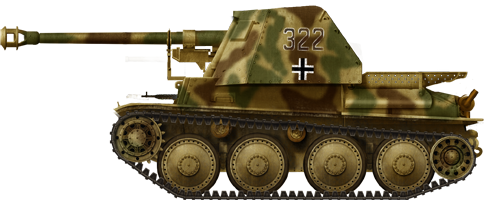
Unknown unit, Italy battle of Anzio, Jan 1944
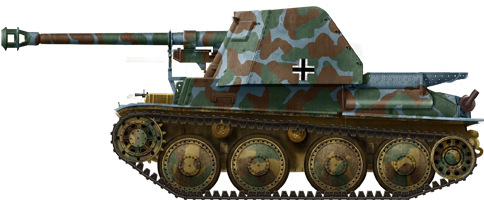
Cp.Jag.Abt.171, 71PzD, Italy, May 1944
Ausf M
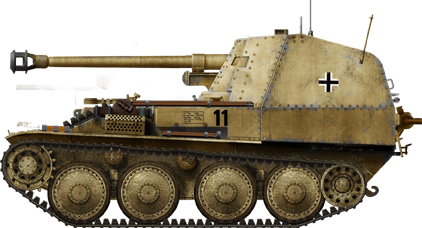
Unknown unit, base factory dunkelgelb
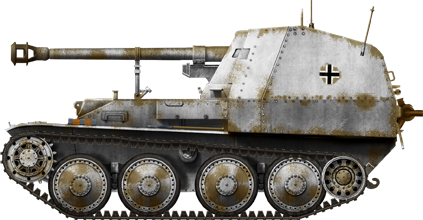
Ausf M in the winter of 1944-45
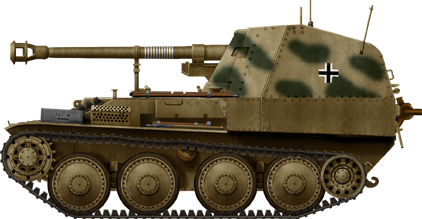
Unknown unit
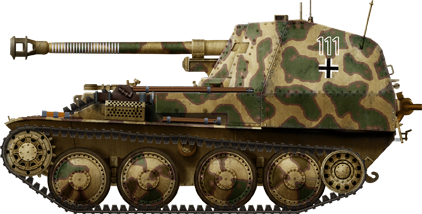
Unknown unit
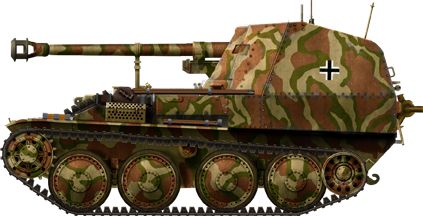
Unknown unit

German-operated Marder 38T drives past a Hungarian Turan tank during a military exercise. To boost their ally’s shattered force, the Germans provided an unknown number of Marder 38Ts to the Hungarians in 1944. Source: S. J. Zaloga Tanks In Operation Bagration 1944

The Marder 38T at the Musée des Blindés in France. Source: Wiki

The Marder 38T exhibited at the Museo di Guerra per la Pace Diego de Henriquez in Trieste, Italy. Positioned behind the tank destroyer is a 17 cm Kanone 18 heavy artillery piece. Source: lasegundaguerra.com

In saving private Ryan (1998)

WW2 Tanks




























WW2 tanks posters

All Tiger tanks liveries.

Panther liveries and variants

WW2 Armour - All tanks











Tanks aces and single tanks series

Find more there

Museums, Movies, Books & Games
The Tanks and Armor in pop culture
Tanks and armored vehicles in general are only really grasped when seen first person: The mass, the scale, it's all there. Explore also the way tanks were covered in the movie industry, in books and in video games.Movies:
Best tanks movie on warhistoryonline.com
On imdb.com
On bestsimilar.com/
miltours.com
liveabout.com/
watchmojo.com
Video Games:
pcgamesn.com
historyhit.com
levvvel.com
vg247.com/best-tank-games
mmobomb.com/
alienwarearena.com

